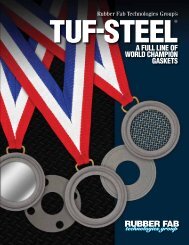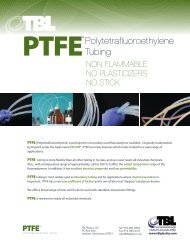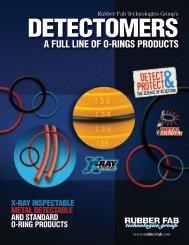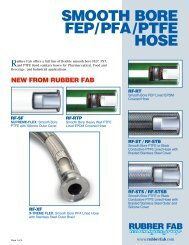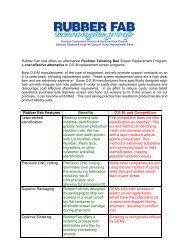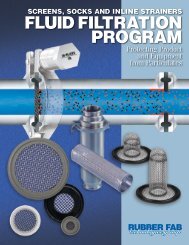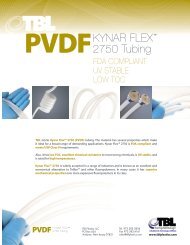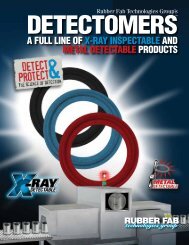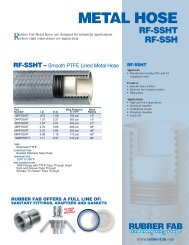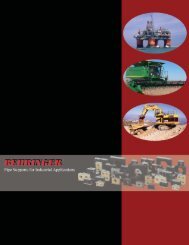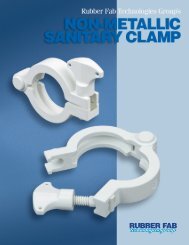HYGIENIC SEAL MATERIAL GUIDELINES
HYGIENIC SEAL MATERIAL GUIDELINES
HYGIENIC SEAL MATERIAL GUIDELINES
You also want an ePaper? Increase the reach of your titles
YUMPU automatically turns print PDFs into web optimized ePapers that Google loves.
<strong>HYGIENIC</strong> <strong>SEAL</strong> <strong>MATERIAL</strong> <strong>GUIDELINES</strong><br />
Exposure Limits<br />
It is important to define the operating parameters of a new or existing processing sanitary<br />
system. The user specifications for exposure limits and reactivity to process fluids are compared<br />
with process operating parameters. All materials are acceptable for steam excluding Buna.<br />
All materials should meet process fluid reactivity parameters. Even though all compound<br />
exposure limits fall within operating parameters, the service life of some compounds will be<br />
different under certain conditions. This must be considered when selecting a compound.<br />
FDA and USP Qualifications<br />
CFR’s define the criteria for extractables and for compounds used in the manufacture of rubber<br />
and plastic articles. The two applicable categories are; rubber articles (Buna, EPDM, FKM<br />
Fluoroelastomer, Silicone) and perfluorocarbon resins (PTFE).<br />
USP defines the criteria for testing biological reactivity and the amount/type of extractables.<br />
The hygienic seals in service must meet USP Class VI specifications, and be manufactured<br />
using the proper compounds as stated in the CFR, Title 21, Sections 177.1550 and 177.2600<br />
respectively. Certificates are available from Rubber Fab Technologies Group verifying compliance<br />
with regulatory requirements, traceability lot and batch and certification lot and batch.<br />
Note: Not all hygienic seals meet these requirements.<br />
Curing Methods<br />
Curing agents have an affect on the amount and type of extractables a material will emit.<br />
Typically, the hygienic seal group in service uses three methods; sulfur cured*, peroxide cured<br />
and platinum cured. When dealing with elastomers, peroxide cured is the most favorable<br />
method. When dealing with silicone, platinum cured is the most favorable. All gaskets shall<br />
be post cured. Using these methods minimize potential reactions with the respective process<br />
fluid applications and can uphold pure water and process fluid standards.<br />
* Sulfur cured elastomers can significantly alter a process fluids integrity and negatively<br />
affect mammalian cell yields.<br />
Note hygienic seal identification for curing methods. For example, EPDM: one green dot (• )<br />
means sulfur cured and three green dots (•••) means peroxide cured.<br />
RUBBER FAB EPDM <strong>HYGIENIC</strong> <strong>SEAL</strong>S ARE ALL PEROXIDE CURED.<br />
What Material(s) Can Be Used<br />
By reviewing manufacturer data and compiling information regarding regulatory requirements,<br />
it appears that any of the aforementioned compounds are suitable for both utility and process<br />
equipment use. However, you must ensure that all hygienic seals and compounds meet the<br />
CFR and USP requirements, and have a certificate to verify compliance.



